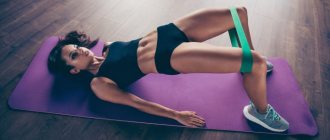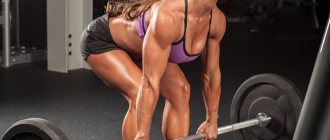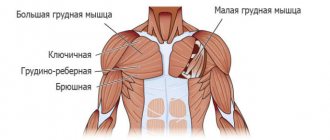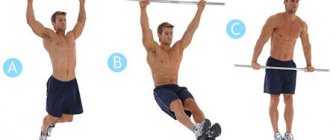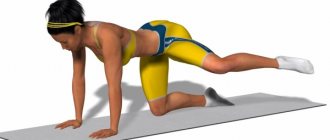Strengthening the muscles of the whole body at home will not require hours of training and dozens of exercises. There are general strengthening exercises within the framework of physical education available to everyone, the implementation of which affects all or most muscle groups of the body.
It is not even necessary to have dumbbells, a sports corner and some kind of exercise equipment.
By choosing 5-6 exercises from the complex to strengthen muscles according to your strength and practicing at home without additional weight for 15-20 minutes every day, after a month you will get a noticeable result - a slim and strong body and a physically healthy body. If you are overweight and need to lose weight, you will need an integrated approach: in addition to basic fitness exercises, connect an effective system of proper nutrition.
Rules for performing exercises from a general strengthening complex
It is recommended to do the entire basic set of exercises at an average pace. Before starting your workout, do a short warm-up to warm up your muscles. As a warm-up, jogging in place or jumping rope is suitable, and also do a few slow bends down to warm up your lower back and twist your body.
For the arms and shoulder girdle, you can take dumbbells weighing 1-2 kg, for lunges and squats - from 4-5 kg.
It is better to perform the exercises from the general strengthening complex program with your own weight without dumbbells, but if you wish, it is not prohibited to use weights.
Any exercise should be performed as accurately as possible according to technique. The harder a movement is for you, the slower you need to do it.
For self-impressed beginners, it’s better to do only 5 repetitions, but correctly, than to do all 30 somehow.
How to start classes
A fitness program for beginners at home requires starting off right. First of all, you need to decide on the goals that will allow you to achieve sports.
What problems should home fitness solve from scratch:
- Pumping up muscles and training physical endurance: the emphasis is on strength exercises. To perform them, use basic sports equipment, for example, dumbbells. Before basic training for strength and endurance, perform a thorough warm-up.
- Losing weight, increasing muscle tone: in this case, aerobic exercise or aerobics is recommended. This training program is characterized by dynamism, since the emphasis is on cardio. Regular aerobic exercise helps speed up metabolism and reduce weight.
Before you begin full-fledged fitness at home, you need to assess your own health. Sports activities are allowed for people who do not have musculoskeletal diseases or chronic ailments in the acute stage. Fitness is contraindicated for those who suffer from obesity and diseases caused by excess weight.
Krasnopir Andrey, fitness trainer
Before the main lesson, a dynamic warm-up is necessary. To warm up the muscles, quick steps to the side and alternately pulling your knees to your stomach in a standing position are suitable. The warm-up contains elements of step aerobics, which help you get ready for the main lesson.
Fitness classes at home are effective only if they are organized regularly with equal intervals between training sessions. To achieve good results, it is recommended to subject the muscles to stress 3-4 times a week.
A set of exercises to strengthen the muscles of the whole body at home
Exercise 1. Squats (classic version)
Squats are an integral part of any muscle strengthening workout. When squats, all the muscles of the lower body, abs, back extensors and other smaller groups are used. The hips and buttocks work most actively, and balance is additionally trained.
Place your feet shoulder-width apart or slightly wider, resting on your entire foot, but a little more on your heels. Start slowly sitting down on an imaginary chair standing behind you, as if it is far away and you need to reach it. It is important that your knees do not go beyond your toes when moving down, and keep your back straight. To maintain balance, extend your arms in front of you.
Having squatted as low as possible, rise back up as slowly as possible, straining your buttocks at the top point. Keep your knees slightly bent until you complete all repetitions. Perform 3 sets of 30 times (beginners can reduce this to 15 at first).
Exercise 2. Plank
When performing the plank correctly, all the muscles of the body are strengthened: the abs, back, chest, buttocks, legs, shoulders and arms. By regularly performing this exercise alone, you can ensure that you strengthen and maintain the overall tone of the muscles throughout your body.
You need to hold the plank for as long as possible. It is advisable to do 3 approaches.
Stand on the mat in a flat horizontal plank with support on your hands and toes. The neck, head, spine, pelvis and legs should form a straight line, with the hands positioned strictly under the shoulder joints. This is a static exercise; there is no need to move here. The main thing is to maintain the correct body position.
To make it more difficult, use the elbow plank variation - lower yourself onto your forearms and stand on your elbows. Elbows – strictly under the shoulder joints.
Exercise 3. Deep lunge
This is also a general strengthening exercise that engages the muscle groups of the lower body, abs and back. At the same time, balance and coordination develop.
Stand up straight, bend your back slightly at the waist. Place your feet hip-width apart. Take a step forward and bend your leg at a right angle. Keep your torso as straight as possible, center of gravity on your front leg. Bend the leg standing behind you at the knee, but the knee should not touch the floor. This leg acts as a spring for lifting.
Rise up from a squat position. Place your back foot towards your front. Repeat the lunge on the other leg. Do 20 lunges on each leg.
Exercise 4. Push-ups
One of the best exercises in the complex to work the muscles of the chest, arms and back. If you find it difficult to do the classic version, do push-ups from your knees.
In the classic version, to properly do a push-up, take a plank pose with support on your palms. Slowly lower yourself as low as possible, maintaining a straight line: back, pelvis and legs. Don't arch your back. The chest should fall strictly between the line of the arms and should not touch the floor.
After this, also slowly return your body to the starting position. Do as many push-ups as you can.
Exercise 5. Strengthening the muscles of the hips and back
Get on all fours. Extend your left leg, keeping it parallel to the floor and not letting it go to the side or bend. Then extend your right arm. Hold this position for 5-15 seconds. Smoothly return to the starting position and do the same with your right leg and left arm.
Fullbody training program
We present to you an effective fullbody training program for building muscle mass and increasing strength. It is universal, suitable for both beginners and experienced athletes or professionals.
1 WEEK
Monday
- Squats with a barbell 3x12 (60-65%*)
- Bench press 5x6 (75-80%)
- Lying dumbbell flyes 3x12
- Barbell curl 4x8
- Press crunches 2x50
Wednesday
- Deadlift 5x6 (75-80%)
- Bench press 3x12 (60-65%)
- Dips (with weights) 4x8
- Standing dumbbell biceps curl 3x12
- Raising legs bent at the knees to press 4x15
Friday
- Squats with barbell 4x8 (70-75%)
- Bench press 4x4 (80-85%)
- Pull-up on the bar 4x8 (with weights)
- Arnold Press 4x8
- Press crunches 2x50
WEEK 2
Monday
- Deadlift 3x12 (60-65%)
- Bench press 4x8 (70-75%)
- French bench press 3x12
- Information in the 4x8 butterfly simulator
- Standing biceps curl 5x6
- Press crunches 2x50
Wednesday
- Squats with barbell 4x8 (70-75%)
- Bench press 5x6 (75-80%)
- Standing barbell press 4x8
- Press to the bottom in a 3x12 block machine
- Raising the EZ-bar for biceps in a Scott bench 4x8
- Straight leg raise for press 4x12
Friday
- Deadlift 5x6 (75-80%)
- Bench press 3x12 (60-65%)
- Vertical block row (lat) 3x12
- Dumbbell flyes lying on a 4x8 bench
- Standing biceps curl 3x12
- Press crunches 2x50
WEEK 3
Fullbody training program
Monday
- Squats with barbell 4x8 (70-75%)
- Bench press 4x4 (80-85%)
- Close grip bench press 4x8 (70-75%)
- Standing dumbbell press 3x12
- Standing dumbbell raises 4x8
- Seated dumbbell biceps curl 4x8
- Hanging bent leg raises (knees) 4x15
Wednesday
- Deadlift 3x12 (60-65%)
- Bench press 4x8 (70-75%)
- Press at an angle of 45 degrees 4x8 (70-75%)
- Lying dumbbell flyes 3x12
- French standing barbell press 4x8
- Lifting dumbbells for biceps in a Scott bench 4x8
- Press crunches 2x50
Friday
- Squats with barbell 4x4 (80-85%)
- Bench press 5x6 (75-80%)
- Dips 4x8
- Pull-ups on the bar (with weights) 4x8
- Raising legs bent at the knees while hanging on a 4x12 bar
WEEK 4
Monday
- Deadlift 4x8 (70-75%)
- Bench press 3x12 (60-65%)
- Dumbbell bench press 4x8
- Standing dumbbell biceps curl 3x12
- Hammer 4x8
- Press crunches 2x50
Wednesday
- Squats with a barbell 3x12 (60-65%)
- Bench press 4x4 (80-85%)
- Dips 4x8
- Lying dumbbell flyes 3x12
- Pull-up on the bar (with weights) 5x6
- Raising straight legs while hanging on a 4x12 bar
Friday
- Deadlift 4x4 (80-85%)
- Bench press 3x12 (60-65%)
- Seated barbell press 5x6 (75-80%)
- 4x8 Dumbbell Side Raise
- Standing biceps curl 3x12
- Press crunches 2x50
download this training program with comments from the link below.
Downloaded: 12425, size: 452.1 KB, date: 12 Jun. 2018
*The weight of the maximum is indicated as a percentage ( % ).
The training will take place at the following intensity (depending on the working weight in the basic exercises):
- 60-65% - light
- 70-75% - average
- 75-80% - above average
- 80-85% - heavy
Auxiliary exercises are included in order to diversify the fullbody training program. Don’t try to get overly tired when doing them, do them “for your own pleasure.” all your power and energy when performing basic exercises for the main muscle groups, that is, in the squat, deadlift, and press.
Tough attitude in training
The cycle consists of 4 weeks , which is repeated again after the last week has passed.
All the main time in training will be spent on performing the main (basic) exercises - squats with a barbell, deadlifts, and bench presses. In each approach, try to give your best , if the workout is easy or medium, try to work more on technique .
do pull-ups without additional burden (weight), if this is difficult for you.
As you progress through the program, your strength results will increase , followed by muscle mass. Do not chase heavy weights, increase the weight on the bar gradually ( 2.5-5 kg in no more than 1-2 weeks).
You don’t have to do the deadlift if you have problems with the spine , or simply don’t have the desire to do it, then in this case, turn on hyperesthesia to strengthen the back muscles, and also on the day when there was a deadlift, replace it with squats with a barbell, respectively, if the deadlift is heavy then heavy squats, if light, then light.
However, we advise beginner athletes not to eliminate the deadlift, since at the initial stage, this exercise is the most effective in gaining muscle mass and strength, and also allows you to feel to a greater extent the mental connection between the muscle and the brain, since it involves almost all muscles in body.
Traditionally, we start training after a thorough warm-up , then move on to the main basic and isolating exercises.
Cool down after training in the gym
At the end of the workout, be sure to do a cool-down, follow the link, you will see a set of exercises for stretching muscles, you need to choose only those that specifically act on the muscles that you trained (for example, if you did squats with a barbell on Monday, then stretching the back surface of the thigh and quadriceps is required), and also do not forget to hang on the horizontal bar to straighten the spinal discs and unload the back, for a speedy recovery.
Exercises to strengthen the thigh and abdominal muscles at home
Exercise 7. Strengthening the inner and outer thighs
This exercise uses several muscle groups, but the inner and outer thighs, as well as the abs, work most actively.
Starting position – lying on your side. Raise your upper leg 30-40 cm from the floor and fix it. Pull your lower leg up to it and lower it back without placing it on the floor.
All movements, both up and down, are performed without jerking, very slowly. At the extreme point – pause for 1-2 seconds. The upper leg is motionless all this time. Do 20 lower leg raises and switch sides. There should be at least 3 such approaches on both sides.
What are basic and isolated exercises?
BASIC EXERCISES - the second name is multi-joint, when 2 or more muscles are involved in the work, and the main load is placed on 1 large one.
ISOLATED EXERCISES - the second name is single-joint, 1 muscle is involved in the work and the emphasis of the load is on it.
Many beginners do not want to do basic exercises, inventing different reasons, but there is only one reason - THIS IS NOT THE DESIRE TO DO THE BASIC, BECAUSE IT IS HARD! Therefore, they bomb the muscles exclusively in isolation, and then they wonder why there is no point.
Basic exercises set the growth and general shape of the muscles, while isolated ones tighten problem areas and make “cosmetological” correction of the figure.
Only rough basic exercises allow you to build strength and mass.





